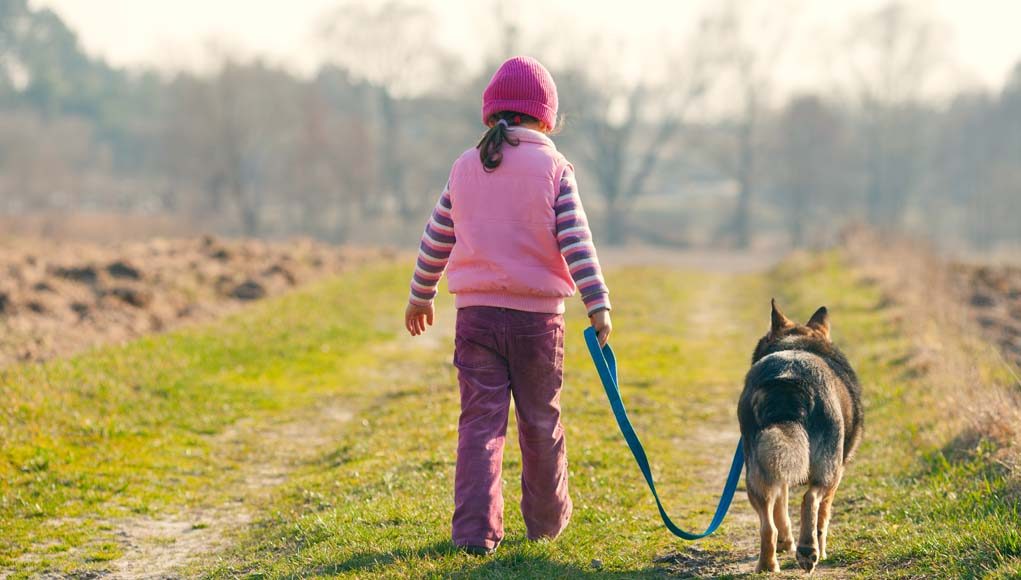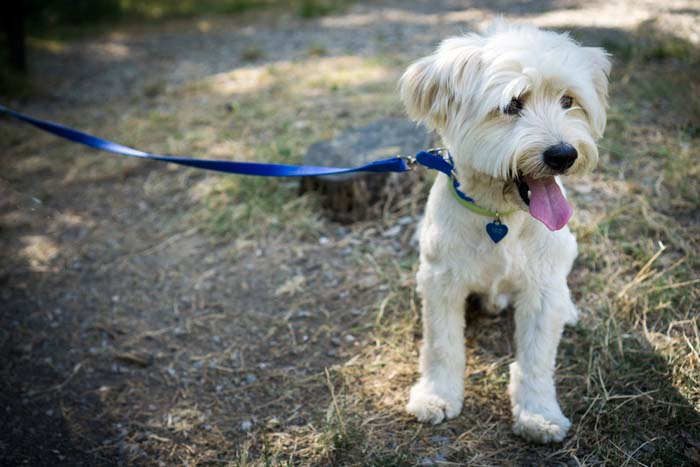Pet owners who want to learn how to teach a dog to walk on a leash must first understand this simple concept – dogs are not born already knowing that pulling on the leash is bad. Simply yanking them by the leash towards you will not fix the problem, because your Fido will not know what this represents.
Another important aspect of learning how to teach a dog to walk on a leash is always reminding yourself that your walking pace is slower than your dog's. Nobody is doing the wrong thing here, neither you nor your dog.
It's simply one of the differences we have: a dog's normal walking pace is faster than a human's. Therefore, it's considerate to acknowledge that when you're teaching your pooch how to walk using a dog leash, you're essentially asking her to get out of her comfort zone and walk in your pace.
Lastly, the secret to successful training of how to stop leash pulling is consistency.
You can simply follow some or all of the advice below, but the key will be to never allow your dog to pull on the leash. Remember, just a couple of times can break the structure of everything you taught your pooch.
FULL GUIDE: How To Train A Dog To Walk On A Leash
Want more interesting and actionable doggy tips for pet parents? Then remember to subscribe to our YouTube channel for DAILY videos with all things dogs and owners.
Top Tips on How to Teach a Dog to Walk On a Leash Safely and Effectively
 The most important preparation for any dog training is making sure that your dog has adequate daily exercise. This is especially true when you're trying to learn how to teach a dog to walk on a leash.
The most important preparation for any dog training is making sure that your dog has adequate daily exercise. This is especially true when you're trying to learn how to teach a dog to walk on a leash.
If your dog knows that the daily walk around the block is all the exercise she's going to get, then most likely she will try to make it as exciting as possible. That means running around, sniffing everything, and probably pulling on the leash.
Until your dog knows how to walk nicely on a leash, consider every daily walk with your Fido to be a training session. Leash training sessions are most effective when they aren't too long, so keep your walks regular but short at first.
Depending on your dog's breed, especially if it's an active dog like a Pit Bull or a German Shepherd, this may well mean you won't be able to get your canine all the exercise that she needs only by walking her on a leash.
Ensure that your dog gets plenty off-leash exercise and roaming freely opportunities. Those can be trips to the dog park or playtime in the back yard. This will provide a good balance for your pooch to become more comfortable using the leash for prolonged periods of time.
Some dog experts advise to schedule these extra exercise sessions right before you plan to do leash training. That's because a thoroughly exhausted dog simply won't be interested in pulling on the leash, and won't have the energy to argue with your commands.
RELATED: 25 Best Dog Books Every Owner Must Read
The Slow Process of Doggy Leash Training
To get the best out of your course of how to teach a dog to walk on a leash, always use the right equipment. Start with a simple training collar, and only resort to fancier training collars if you really need the extra help. Make sure the collar is snug, but don't make it so tight that it's bothersome.
When choosing your first leash, go for something short. Shorter leashes give you more control over your dog. Attach the leash and collar near the top of your dog's neck.
The first step is to teach your dog not to hate the leash and collar.
Some dogs accept being leashed very quickly, whereas others seem deeply offended by the concept. Begin by attaching your dog's collar when she's going to be distracted by something fun, e.g. before playtime or mealtime.
After a few days, when your dog has accepted that the collar isn't all that bad, try attaching the leash to it. Don't hold the leash at first, just let it drag behind her as she goes about her business. Again, make sure she has something fun to do that will keep her distracted. Be sure to supervise, as you don't want the leash getting caught on something.
When your dog is comfortable wearing the collar with the leash attached, start picking up the leash and calling your dog towards you. Pull lightly on the leash if she seems reluctant. Reward her with a small treat when she complies.
Use this method to slowly work your way up to holding the leash and walking your dog around the house.
Always have treats nearby, and keep one in your leash hand. Every now and then, get your dog to sit, give her the treat, and then resume walking. Once you're reliably walking around the house, you're ready to move on to the great outdoors.
RELATED: How to Housebreak a Puppy Effectively
Continuing Dog Leash Training Outdoors
The transition from learning how to teach a dog to walk on a leash indoors to walking outdoors typically goes one of two ways.
For timid dogs, you might find that they refuse to walk on the leash outdoors, especially near loud noises like busy roads. In this case, start by teaching your dog to walk in a safe, quiet location, like a park.
If she still refuses to walk, move away from your dog, kneel down, and call her towards you with a treat. Repeat multiple times. This will be a bit tedious, so bring plenty of patience with you on every walk. Eventually, with consistent practice, your dog will learn to trust your lead. Keep in mind that some very timid puppies end up growing into some very adventurous dogs.
Those dogs that are adventurous right off the bat will want to explore every nook and cranny of the exciting outdoor world. This usually means lots of pulling on the leash. Most dogs end up pulling sooner or later, so let's look at how to manage that.
Which dog leash to use for outdoors and indoors training? It depends on your situation and how you're training, and what for. Here are a few considerations:
How to Deal with Dog Pulling on the Leash
Naturally, dogs move differently than people. Dogs are faster, dogs sniff everything, and dogs urinate in public. Most people don't.
It shouldn't be surprising then that tying a dog to a person with a leash can cause some disagreements on what's the best procedure for daily walks.
When your dog is misbehaving by pulling, she's trying to convince you that her way of going for walks is infinitely more interesting than your boring old strut down the sidewalk. Unfortunately for her, you are the boss, and she has to learn to walk your walk – not the other way around (but there's a lesson to be learned for sympathetic dog owners, too).
Start your walks “on the right foot”. Many dogs get extremely excited when they figure out that you're about to go for a walk. If you tie a hyper dog to a leash and step out the door, you're just begging to get yanked around.
Before attaching your dog, wait for her to calm down. If she starts acting up again when you leash her, wait for her to calm down before opening the door again.
If she bolts away the second you open the door and starts dragging you behind her, then plant yourself firmly on the ground and wait for her to calm down. With this sort of consistency, she should learn that she has to be calm and orderly in order to get what she wants.
Once you get outside, keep sending the same consistent message to your dog.
If she pulls on the leash, tell her no, stop, and call her back to you. Do this every time she pulls. She'll learn that pulling ahead to go sniff that fire hydrant ultimately means she has to go all the way back to you, and she'll figure out that it's quicker and easier just to wait for you to get there.
FULL GUIDE: How To Stop A Dog From Pulling – Step-By-Step Instructions
As always, be consistent. If your dog learns that pulling works at least some of the time, then she'll keep trying all of the time, just in case.
In particular, don't make exceptions and allow your dog to pull just because she needs to find a bathroom spot. Watch for signs that your dog needs to go, and go stand on a patch of grass. Teach her that the spot of grass within leash's reach of you is just as good as the grass two meters away.
Most importantly, keep in mind that you are asking a lot from your dog when you put her on a leash.
As a compromise, try to accommodate your pooch as well; try to walk at a brisk pace, for example. It won't be as fast as your dog really wants to go, but it will make her more eager to follow your lead.
READ NEXT: 21 Must-Know Dog Training Tips
















